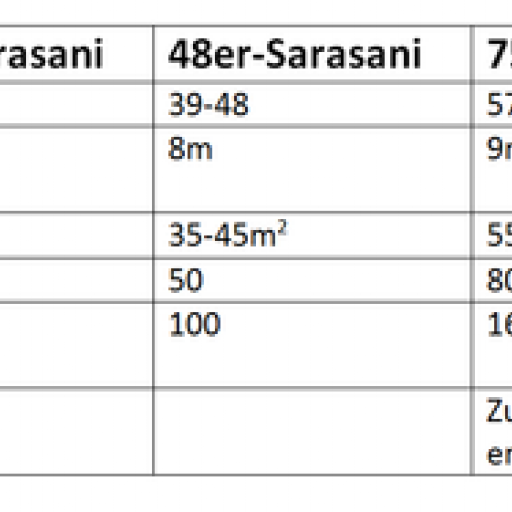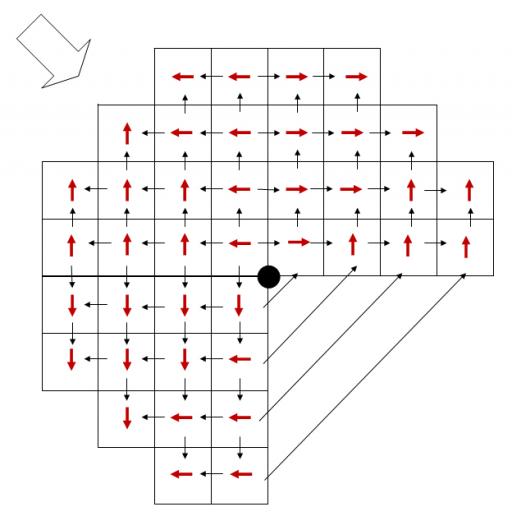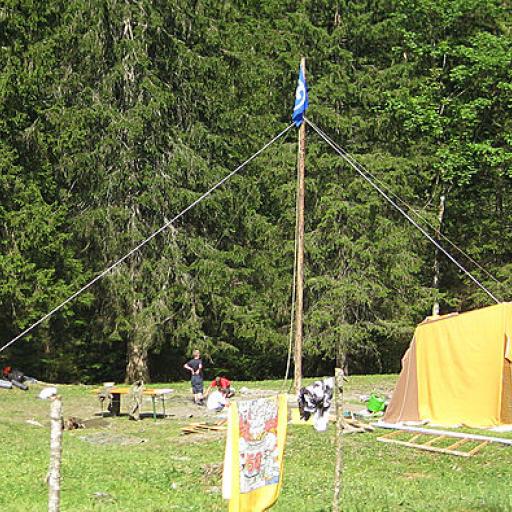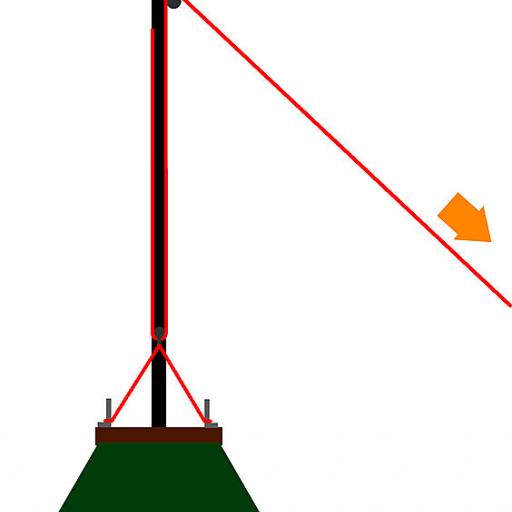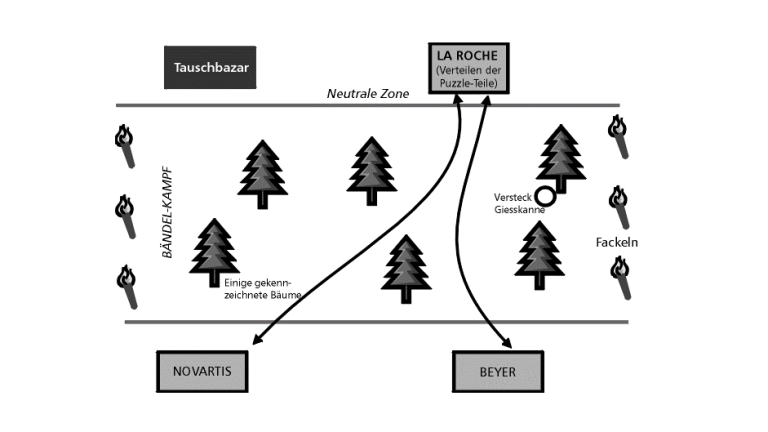The Sarasani is a large group tent, woven from military banners. A Sarasani can be built in a variety of sizes, depending on how many sheets are used and how tall the structure is.
The Sarasani is knotted from three squares of canvas. In theory, the shape of a Sarasani corresponds to a tetrahedron (pyramid with 3 edges).
Dimensioning of a Sarasani
To determine the size of a Sarasani, there are some guidelines. Decisive is how many people standing or sitting place müssen find. From the below können guideline values für the various Sarasanigrössen are taken.
Achtung: The values are guidelines, real values vary depending on the steepness of the tent very much.
Number of Military Blades
After you have determined the basic type to be used with the help of the Sarasani size table, you have to define how many blades should definitely be used.
Basically, a Sarasani consists of 3 blade squares, which are knotted together to form a pyramid. If the side length of such a partial square is 4, this results in 48 sheets (4x4=16 per partial square *3=48 sheets). This corresponds to the 48 type.
In practice, however, the outer corners of the sarasani are often removed, as these usually only increase the usable area insignificantly. If, for example, you take away the three outermost panels from each of the three partial squares of the 48 type, you get a total of 39 panels
It is not possible to say definitively whether and how many panels should be removed from a particular type; it depends on the situation and is also a question of philosophy.
One problematic point of the Sarasani is often the low incidence of light. If you do not install any additional lighting, it is recommended, especially with the 75 and 108 type, to snap in about 3 translucent baffles. These are tarpaulins with a recessed window (plastic sheeting).
It should always be considered in advance how the sheets must be knotted together and how the nets must be placed. It is a good idea to prepare a plan so that you can show it to the young learners as you knot.
The following is an example of a 39-blade Sarasani. The black arrows denote the overlap of the knots. The red arrows indicate the direction of the noses of the sheet. The large arrow indicates the prevailing wind direction
Mast
The minimum mast heights can be taken from the Sarasani size table. The mast should be made of a solid trunk that is as straight as possible and not too old (or even rotten)
The mast should be sunk min. 50cm optimal but >=100cm in the ground. Before setting up the mast, it is essential to prepare the canvas suspension (see below).
Since the mast is not old (or even rotten), it is recommended to set it up in the ground
Since the mast will be tensioned later with ropes, these must be fastened in advance. There are several ways to do this. A very common method is to use 2 ropes, each of which is attached to the top of the mast in the middle of the rope with a masthead. Later they are stretched diagonally across the Sarasani. These ropes are also used to help set up the mast.
When the mast is in the hole, large stones are driven into the ground along the mast to stabilize it. The mast should already be stable without bracing!
Afterwards the mast is braced to big plants (double plants are recommended)
As an alternative to a mast, a Sarasani can also be hoisted on a taut rope (only for small runs!!!) or a cross mast. This offers itself especially in wooded areas.
Sheet suspension
The most critical point of a Sarasani is the construction with which the sheets are connected to the mast.
Since large loads are placed on the sheets at this point, the sheets should not be tied directly with ropes.
A common method is to clamp the top three sheets between two wooden triangles. To do this, you need two solid wooden triangles (equilateral, approx. 115cm side length), preferably made of solid wood (e.g. oak). Screw clamps or similar can be used for clamping. With this construction a hole remains open at the top of the tent. If necessary, it can be closed with an additional baffle.
The little rain that penetrates so stört, however, rarely too strong. In addition, the Öffnung is an additional source of light and serves as an exhaust airöffnung.
Another important point is the attachment of the ropes and possibly Röllchen / carabiners at the top of the mast. Most of the time this is done with the help of ropes. Alternatively, a building clamp can be used. This can simply be rammed into the mast. You can get building clamps in construction shops, for example
To pull up the canvas on the mast you can use a pulley. On the one hand it is easier to pull up the sheets and on the other hand the material is spared (half the pulling force on the rope). A possible pulley block is shown below
Planning
Basically a Sarasani has to be planned very well. Especially if you are setting up a Sarasani for the first time, or if you want to build a special Sarasani shape, it is a good idea to make a model of the Sarasani in advance
There are 2 ways to do this:
- You print out the sheet plan of the Sarasani and glue it, together to form the shape of the Sarasani. (See picture below)
- You make a net of strings to represent the canvas and hang it on a pole of the same scale
A model is also always suitable to show the co-leaders and the boys how the Sarasani should look like later. Because often these have Mühe to imagine it können, for example, when knüpfen the banners.
Advantages / Disadvantages
Advantages
- Very imposing
- large
- relatively cool
- high (partly also fire in the tent möglich)
even in summer
Disadvantages
- Large attack surfaces for the wind
- large loads for the material
- large material loads
- Ratio of sheets/usable area is not optimal
Safety advice
A Sarasani has some safety risks. So it is not so much the dead weight that is the problem (although this is also often über 150kg), but rather the large attack surface forür wind and rain.
The following points should definitely be considered:
- The Sarasani must not be entered under any circumstances during thunderstorms (risk of lightning strikes)
- During storms, the tarpaulins should be lowered to prevent them from tearing
- No hemp ropes should be used to guy the mast (problems with nässe)
- The planks to which the ropes are tensioned must be designed to remain firmly anchored even when the ground is wet
- When setting up and putting down the mast, children should only be at a safe distance.
Image credits
- Title photo: 39-Blachen Sarasani (09.07.2010), provided by the Jungschar Schinznach / Manuel Meier
- Graphics and pictures: Provided by the Jungschar Schinznach / Manuel Meier
Content may be automatically translated. Help improve the quality of the translation with your editing!

